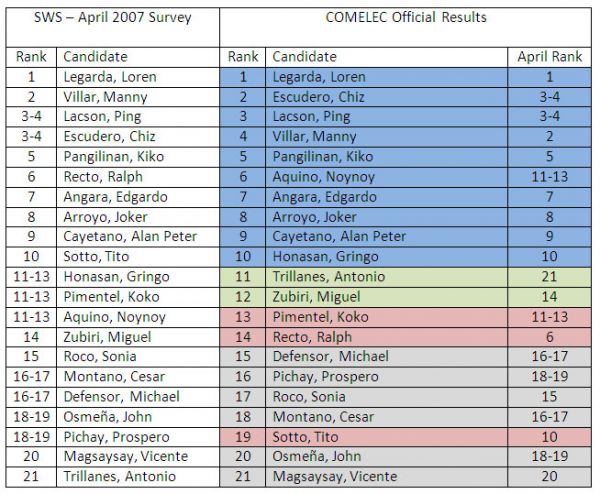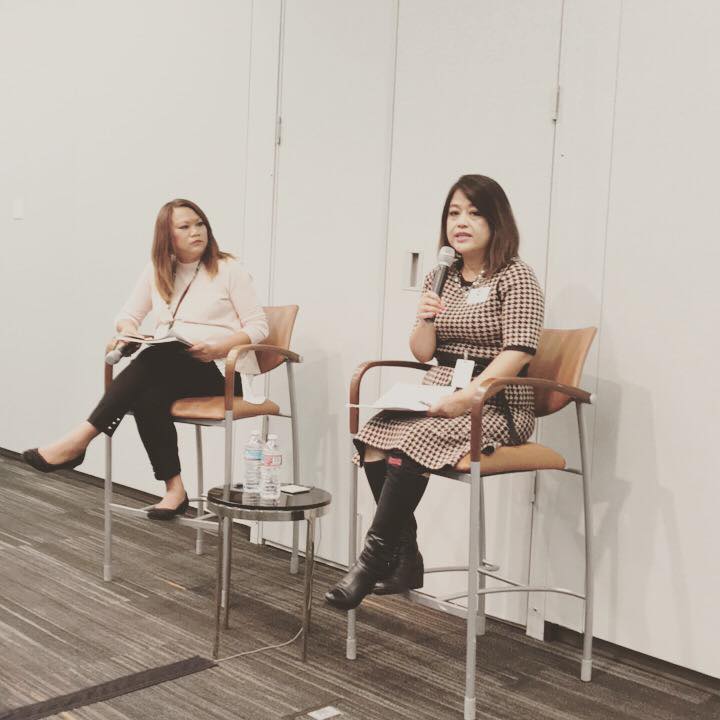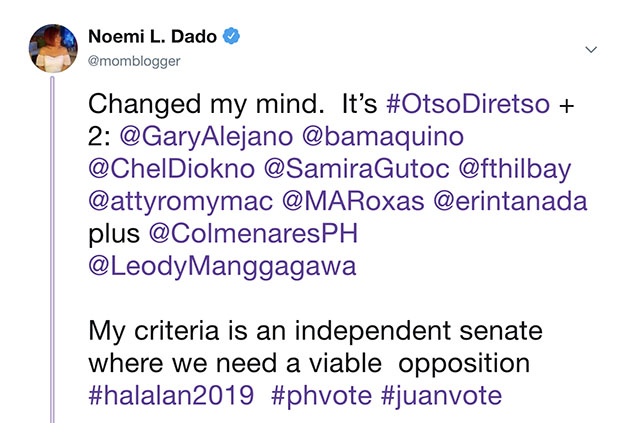How surveys are volatile a month before election
By Benj Espina
The senatorial election is one of the most fluid and unpredictable in the Philippine electoral system. There are just too many candidates and many slots for people to be effectively predict who would get enough votes to score the six years in office. This is a big deal since only the President and the senators get the privilege of serving that long. All other elected positions end after just three years on the job.
The Social Weather Station has been at the helm of running surveys at an almost monthly basis during the lead up to Election Day. Interestingly, the surveys done during April –usually towards the middle part – has been somehow predictive but still not 100% failsafe in determining who gets to win and who gets to cry in the corner after spending millions of pesos in a failed campaign.
The past decade has seen three senatorial elections – all three featured April surveys that were slightly off on how the actual results played out after the Commission on Elections counted the ballots.
2001
The 2001 Senatorial Election is one of the most divisive in the history of the Philippines. It was just a few months removed from the bitter drama and controversy of then-President Joseph Estrada’s impeachment trial and most people were just really riled up on how certain senators voted not to open the second envelope. Most survey firms predicted a very strong showing for the administration party who were the main people behind the anti-Estrada bloc in the Senate. The political veterans who were on the other side of the fence were quite vulnerable despite their stature as stalwarts in the Senate. The 2001 Senatorial Elections somehow turned into a referendum on how people wanted the country to move forward with the consideration of Erap Estrada’s fate as an alleged plunderer was hanging in the balance.
Due to the appointment of Senator Teofisto Guingona as Gloria Macapagal-Arroyo’s Vice-President for the remainder of her term, a seat was vacated in the Senate. The Supreme Court ruled that thirteen senators will be declared winners for the 2001 Elections with the final winner serving out the remaining three years of Guingona’s term instead of the usual six.
The table above shows how much the rankings changed during the month in between one of SWS’ surveys for the month of April and the actual COMELEC results come Election Day. The candidates that are in the blue field represent those who were able to hang on to their projected win from one month before the polls. The candidates in the green fields show those who have overcome the odds and made a successful bid to break into the top thirteen spots. Those in the red are those who were projected to have a realistic chance of winning but eventually lost while those in the gray are those who weren’t seen as potential winners in April and ended up not winning in the COMELEC count as well.
The most stunning result in this table is the fact that Loi Ejercito managed to win and climb back from a dismal 18th in the surveys to the 11th spot in the actual COMELEC count. Despite the great bias against her husband, Loi Estrada was able to get the upwelling of support from the people who felt that there was something wrong with the so-called People Power 2 Revolt in EDSA. We should also not forget that the elections were just a few days removed from the fortuitous events of the “EDSA TRES” movement that had a violent dispersal on May 1, 2010. It could be surmised that a few sectors did see it as a genuine divide in Philippine society and both sectors – not just one slate – needed to be represented in the Senate as the nation moves forward.
Then re-electionist-Senator Gringo Honasan is a veteran of many failed power grabs in the past and despite his resume that would likely scare off voters, he has captured the imagination of the Filipino voter. He was only projected in the 15th-16th range in April but he managed to squeeze in to the 13th spot. There were three senatorial hopefuls who were tied at the bubble ranks of 12th to 14th – incumbent senators Juan Ponce Enrile and Miriam Defensor Santiago along with Police Chief Panfilo Lacson – had very different fates. The three candidates were heavy weights in their own right but were clearly hurt with their association with Joseph Estrada. Lacson would eventually surge to propel himself to tenth place despite the allegations regarding the Dacer-Corbito case. Both Enrile and Santiago would lose and take up the spots just after the final winning seat.
Former senator and TV personality Orly Mercado had a dramatic and precipitous drop. Mercado had a very curious political topsy-turvy during the early parts of 2001. He was among the eleven senators who vote against the opening of the second envelope. On a total 180, Mercado went to the EDSA Dos and was subsequently booed and heckled by the waiting crowd thinking that he was merely posturing for votes. This public jadedness was clearly warranted when Mercado ended running as a candidate under Erap’s Puwersa Ng Masa coalition for the 2001 polls. Mercado was able to do full circle in less than five months! From a projected placing of 10th, Mercado languished at 18th – some three million votes out of the 13th spot.
Despite winning, Ralph Recto’s position was a bit of a concern since he only won an extra three year term by a very slim 26 000 vote margin over Honasan. Despite being projected as a finisher safely within the top eight.
For the most part, the April survey was successful in predicting the winners of the election but there were certainly a lot of surprises. Eleven of thirteen is a good batting average but the two seats that theoretically became owned by two other people is a significant difference to the projections. Save for the first few ranks, the placings did change a lot as well.
2004
The 2004 Election was a political crossroads for Philippine society. There were more or less equal people who were disgruntled with the way the country was being run by the incumbent President but a lot were still very averse to the idea of having Estrada’s cohorts and a very inexperienced Fernando Poe Jr. back in power.
The 2004 senatorial election was no different. There was certainly a lot of color surrounding the vote. A lot of new name candidates went forward in hopes of representing the new brand of politics that a now jaded nation wanted to see from its leaders.
The April surveys were successful in predicting ten of the twelve winners for the senate race but the rankings were absolutely all over the place. The two candidates who were able to leapfrog and jump the line to the winners’ circle included surprise top-half finisher Pia Cayetano who was ranked 15th with just a month to go in the senate race. Rodolfo Biazon was able to make a somewhat smaller – but definitely significant leap – as he crept from 14th to 12th in just one month – just in time to claim yet another six-year term.
Three senators who were projected to win had the polls been held in April ended up losing and taking up the 13th to 15th spots during the actual election. Robert Barbers missed the last ticket to the Senate by just a heart breaking margin of less than 11 000 votes against party-mate Biazon. Ernesto Maceda – projected 12th or 13th – by the SWS poll ended up in 14th. Maceda ran a campaign on is penchant for exposes and explosive revelations in the Senate but he still finished almost 700 000 votes short of his goal of another term in office. John Osmeña was actually safely projected into the 8th to 11th range but was only good for 15th in the COMELEC results.
The ranking up top were pretty much mucked up. Both Jamby Madrigal and Richard Gordon were a bit low-balled at just 8th-11th in the April surveys but both finished with a strong fourth and fifth place standing in the COMELEC count. One could easily remember that both candidates enjoyed the use of significant airtime with their political advertisements on television. If the projections and trends were to be stretched until January of 2010, it would be clear that the SWS has tracked the dramatic rise in both of the candidates’ chances of winning from their dismal late-teens ranking in earlier surveys to their projected win in April. As mentioned earlier, Cayetano improved by nine ranks from a so-so 15th to a strong sixth place ranking.
The top notcher of the senate race is also an interesting side light. Mar Roxas won as the nation’s leading senator with over 19 million votes – almost four million votes ahead of second-running Bong Revilla. Roxas did flood the airwaves with his advertisements but his rise to the top is absolutely eye-popping. Roxas was actually ranked 17th in January before he gained his footing in succeeding months as a real contender and later on, as a lock for a seat in the Senate.
Juan Ponce Enrile redeemed himself by winning in 2004 after a loss in 2001. Despite being projected third, he only finished 9th overall. Jinggoy Estrada was expected to be in the top five but the final month saw him hurtling down to 10th once the ballots were already counted. Administration bet Lito Lapid likewise fell from grace and came dangerously close to losing. Lapid was expected by pollsters to finish 7th as of April but he ended up ranking 11th and just fewer than 400 000 votes clear of defeat.
2007
The 2007 Senatorial elections will be forever cited as one of the biggest reasons why senatorial candidates should never give up no matter what the surveys say even with just one month to until Election Day. The biggest story of the 2007 elections and perhaps the entire decade’s worth of senatorial elections is the victory of Antonio Trillanes IV. Despite being arrested for his involvement in the Oakwood Mutiny, Trillanes was able to win by capitalizing on the brewing public dissatisfaction with the Arroyo government.
Trillanes did what seemed was impossible. Despite being behind bars and having limited political machinery and resources to stage a nationwide campaign, the then-thirty-five year old Senator still managed to climb up from just 21st in the April surveys to an 11th place finish in the actual polls. He won the seat with a margin of over 200 000 votes over the 13th-ranked senator.
Noynoy Aquino was given a slight chance of losing with a projected rank of 11-13. The scion of the Aquino clan managed to surge in the final month to finish in the upper half of the draw.
Another senator who was not projected to win managed to grab the final seat in the polls. Miguel Zubiri ran a campaign based on his advocacy for the environment and his penchant for novelty songs. He improved on his projected rank of 14th just in time to snatch the final slot away from Koko Pimentel by just over 20 000 votes. This remains to be a very controversial victory to this day and the Electoral Tribunal is still reviewing the case.
Two of the three drop outs from the list were both from the administration party. Koko Pimentel was from the opposition and suffered a very heart breaking defeat against Miguel Zubiri. Ralph Recto was projected to finish in the upper half had the elections been done in April but he ended up stuck in 14th and almost 300 000 votes out of the winners’ circle. Former senator Tito Sotto lost his steam as he hurtled from the 10th to the 19th spot in a matter of a month.
Conclusion
For the most part, the surveys have been able to predict a good number of the winners based on the surveys taken from a month before the polls. Having a rate of 31 of 37 is quite acceptable but there have been some very glaring departures from the norm and as the figures show, no one is safe from the statistical anomalies that can happy. There have been interesting surges – Loi Ejercito in 2001, Pia Cayetano in 2004 and Antonio Trillanes IV in 2007. There have been also mind-blowing drops in popularity like in the case of Orly Mercado in 2001 and Ralph Recto and Tito Sotto in 2007.
Surveys are meant to be scientific and indicative of a certain snapshot of time but at the end of the day, voters can still be quite finicky and fickle with thirty days to go.




